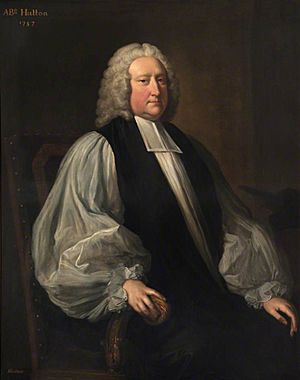Matthew Hutton (archbishop of Canterbury) facts for kids
Quick facts for kids The Most Reverend and Right Honourable Matthew Hutton |
|
|---|---|
| Archbishop of Canterbury | |

Portrait by Thomas Hudson
|
|
| Church | Church of England |
| Enthroned | 1757 |
| Reign ended | 1758 (death) |
| Predecessor | Thomas Herring |
| Successor | Thomas Secker |
| Other posts | Archbishop of York (1747–1757) Bishop of Bangor (1743–1747) |
| Personal details | |
| Born | 3 January 1693 Marske, Yorkshire |
| Died | 18 March 1758 (aged 65) Duke Street, Westminster |
| Buried | St Mary-at-Lambeth, London |
| Nationality | English |
| Denomination | Anglicanism |
| Spouse | Mary Lutman (m.1732) |
| Education | Ripon Grammar School |
| Alma mater | Jesus College, Cambridge |
Matthew Hutton (born January 3, 1693 – died March 18, 1758) was an important leader in the Church of England. He held two very high positions: first, he was the Archbishop of York from 1747 to 1757. After that, he became the Archbishop of Canterbury in 1757, which is the most senior leader in the Church of England. He served in this role until he passed away the following year.
Contents
Early Life and Education
Matthew Hutton was born in a place called Marske near Richmond in Yorkshire, England. His father was John Hutton.
He went to Ripon Grammar School for his early education. Later, he studied at Jesus College, Cambridge, starting in 1710. He earned his first university degree in 1714 and a master's degree in 1717. He also became a fellow at Christ's College, Cambridge, from 1717 to 1727. In 1728, he received his Doctor of Divinity degree, which is a very high academic honor in theology.
Interestingly, Matthew Hutton studied at Cambridge at the same time as Thomas Herring. Matthew Hutton would later take over Thomas Herring's roles in the church, one after another.
Church Leadership Roles
In 1736, Matthew Hutton became a special chaplain to King George II. This meant he advised the King on religious matters. From 1737 to 1739, he was a Canon at St George's Chapel, Windsor Castle, a famous church. He also served as a rector (a type of priest) in places like Trowbridge and Spofforth in Yorkshire.
Becoming a Bishop and Archbishop
Matthew Hutton's career in the church continued to grow. In 1743, he became the Bishop of Bangor. A bishop is a senior member of the Christian clergy.
Then, in 1747, he was appointed Archbishop of York. An archbishop is an even higher leader, overseeing many bishops and churches in a large area.
Finally, in 1757, he reached the highest position in the Church of England: Archbishop of Canterbury. Sadly, he passed away the very next year, in 1758. He never got to live in Lambeth Palace, which is the official home of the Archbishop of Canterbury.
Possible Discovery of His Coffin
In 2016, something interesting happened during renovations at the Garden Museum. This museum is located in the old church of St Mary-at-Lambeth in London. Workers found 30 lead coffins buried there. One of these coffins had a red and gold mitre (a special hat worn by archbishops) on top of it.
Church records showed that two archbishops were clearly identified by nameplates on their coffins. Records also suggested that three other archbishops, including Matthew Hutton, were likely buried in the same vault. This means his coffin might have been among those discovered.

